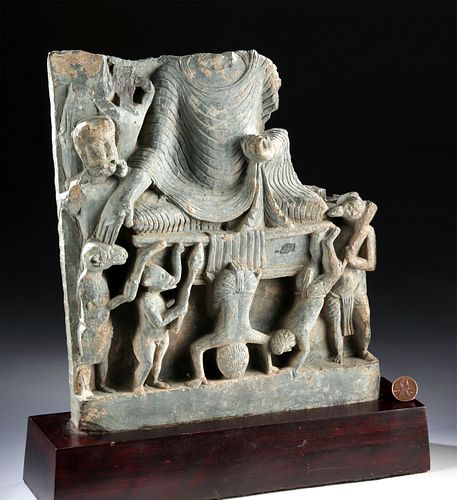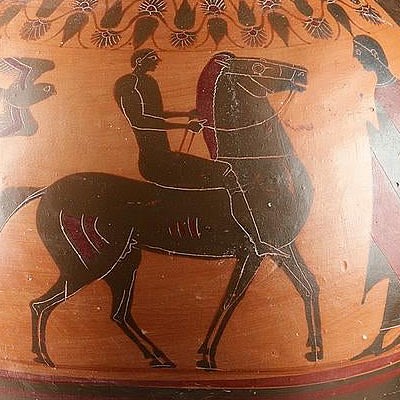Gandharan Schist Panel - Buddha, Acrobats, Animals
Lot 104b
About Seller
Artemis Gallery
686 S Taylor Ave, Ste 106
Louisville, CO 80027
United States
Selling antiquities, ancient and ethnographic art online since 1993, Artemis Gallery specializes in Classical Antiquities (Egyptian, Greek, Roman, Near Eastern), Asian, Pre-Columbian, African / Tribal / Oceanographic art. Our extensive inventory includes pottery, stone, metal, wood, glass and textil...Read more
Categories
Estimate:
$4,000 - $6,000
Absentee vs Live bid
Two ways to bid:
- Leave a max absentee bid and the platform will bid on your behalf up to your maximum bid during the live auction.
- Bid live during the auction and your bids will be submitted real-time to the auctioneer.
Bid Increments
| Price | Bid Increment |
|---|---|
| $0 | $25 |
| $300 | $50 |
| $1,000 | $100 |
| $2,000 | $250 |
| $5,000 | $500 |
| $10,000 | $1,000 |
| $20,000 | $2,500 |
| $50,000 | $5,000 |
| $100,000 | $10,000 |
| $200,000 | $20,000 |
About Auction
By Artemis Gallery
Jun 4, 2020
Set Reminder
2020-06-04 10:00:00
2020-06-04 10:00:00
America/New_York
Bidsquare
Bidsquare : Exceptional Antiquities, Asian, Ethnographic
https://www.bidsquare.com/auctions/artemis-gallery/exceptional-antiquities-asian-ethnographic-5185
An important one-day auction featuring museum-worthy examples of Egyptian, Greek, Roman, Etruscan, Near Eastern, Far East / Asian, Pre-Columbian, African / Tribal, Oceanic, Native American, Spanish Colonial, Russian, Fossils, Ancient Jewelry, Fine Art, so much more! Artemis Gallery info@artemisgallery.com
An important one-day auction featuring museum-worthy examples of Egyptian, Greek, Roman, Etruscan, Near Eastern, Far East / Asian, Pre-Columbian, African / Tribal, Oceanic, Native American, Spanish Colonial, Russian, Fossils, Ancient Jewelry, Fine Art, so much more! Artemis Gallery info@artemisgallery.com
- Lot Description
Central Asia, Pakistan and Afghanistan, Gandharan Empire, ca. 200 BCE to 100 CE. A carved relief schist panel, made to decorate the walls of a temple or palace. It depicts a fabulous scene: the body (with only the head and part of one arm lost) of seated Buddha, wearing draped robes and with his knees crossed, his hands positioned in the Bhumisparsha mudra, with his right hand over the right knee reaching towards the ground and the palm inward and touching the lotus throne. His left hand lies in his lap with the palm upright. This mudra represents the moment of his awakening, as he defeated the demon Mara, and claimed the earth as his witness to his enlightenment. On one side of him is an attendant figure with a quizzical face; below him are two acrobats, one standing on his head, the other mid-tumble; flanking these figures are people wearing animal head masks - a ram, a deer, and an elephant. Size: 9.1" W x 10.3" H (23.1 cm x 26.2 cm); 12.4" H (31.5 cm) on included custom stand.
The acrobats and performers seen here are part of the Greek legacy that inspired artists in Gandhara to create Greco-Buddhist art. With the Greeks, and via the Greek-influenced Seleucid Empire and Greco-Bactrian kingdoms, the Gandharans became interested in professional athletes and created gymnasiums in the Greek style. They even worshipped Heracles as the Buddhist Vajrapani, god of strength.
Provenance: private East Coast, USA collection; ex-private Hiroma collection, Japan, acquired in 1986
All items legal to buy/sell under U.S. Statute covering cultural patrimony Code 2600, CHAPTER 14, and are guaranteed to be as described or your money back.
A Certificate of Authenticity will accompany all winning bids.
We ship worldwide and handle all shipping in-house for your convenience.
#146902Piece is a fragment as shown, with the top and part of the panel lost. There are also small losses to the figures, with scratches, chips, and nicks commensurate with age and some encrusted deposits, mainly in lower profile areas. Many of the figures present are nicely preserved and clear.Condition
- Shipping Info
-
All shipping is handled in-house for your convenience. Your invoice from Artemis Gallery will include shipping calculation instructions. If in doubt, please inquire BEFORE bidding for estimated shipping costs for individual items.
-
- Buyer's Premium



 EUR
EUR CAD
CAD AUD
AUD GBP
GBP MXN
MXN HKD
HKD CNY
CNY MYR
MYR SEK
SEK SGD
SGD CHF
CHF THB
THB














